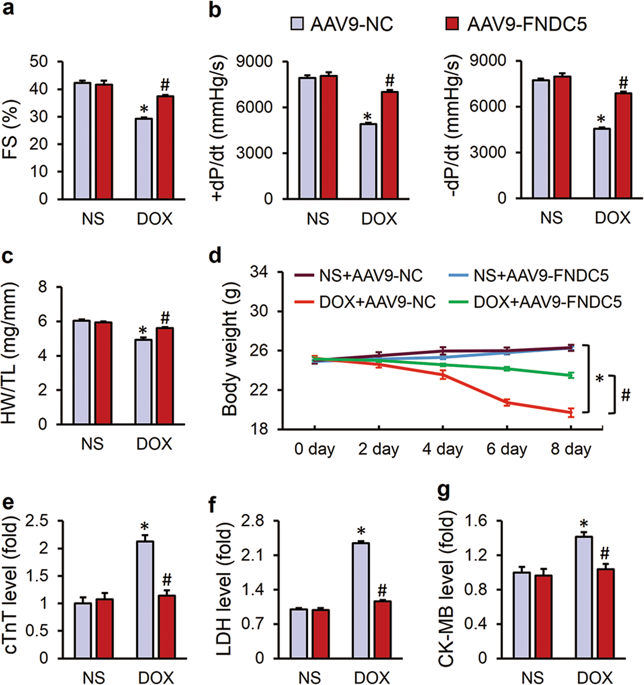当前位置:
X-MOL 学术
›
Cell Death Differ.
›
论文详情
Our official English website, www.x-mol.net, welcomes your
feedback! (Note: you will need to create a separate account there.)
FNDC5 alleviates oxidative stress and cardiomyocyte apoptosis in doxorubicin-induced cardiotoxicity via activating AKT.
Cell Death and Differentiation ( IF 13.7 ) Pub Date : 2019-06-17 , DOI: 10.1038/s41418-019-0372-z Xin Zhang 1, 2, 3 , Can Hu 1, 2, 3 , Chun-Yan Kong 1, 2, 3 , Peng Song 1, 2, 3 , Hai-Ming Wu 1, 2, 3 , Si-Chi Xu 1, 2, 3 , Yu-Pei Yuan 1, 2, 3 , Wei Deng 1, 2, 3 , Zhen-Guo Ma 1, 2, 3 , Qi-Zhu Tang 1, 2, 3
Cell Death and Differentiation ( IF 13.7 ) Pub Date : 2019-06-17 , DOI: 10.1038/s41418-019-0372-z Xin Zhang 1, 2, 3 , Can Hu 1, 2, 3 , Chun-Yan Kong 1, 2, 3 , Peng Song 1, 2, 3 , Hai-Ming Wu 1, 2, 3 , Si-Chi Xu 1, 2, 3 , Yu-Pei Yuan 1, 2, 3 , Wei Deng 1, 2, 3 , Zhen-Guo Ma 1, 2, 3 , Qi-Zhu Tang 1, 2, 3
Affiliation

|
Oxidative stress and cardiomyocyte apoptosis play critical roles in doxorubicin (DOX)-induced cardiotoxicity. Previous studies indicated that fibronectin type III domain-containing 5 (FNDC5) and its cleaved form, irisin, could preserve mitochondrial function and attenuate oxidative damage as well as cell apoptosis, however, its role in DOX-induced cardiotoxicity remains unknown. Our present study aimed to investigate the role and underlying mechanism of FNDC5 on oxidative stress and cardiomyocyte apoptosis in DOX-induced cardiotoxicity. Cardiomyocyte-specific FNDC5 overexpression was achieved using an adeno-associated virus system, and then the mice were exposed to a single intraperitoneal injection of DOX (15 mg/kg) to generate DOX-induced cardiotoxicity. Herein, we found that FNDC5 expression was downregulated in DOX-treated murine hearts and cardiomyocytes. Fndc5 deficiency resulted in increased oxidative damage and apoptosis in H9C2 cells under basal conditions, imitating the phenotype of DOX-induced cardiomyopathy in vitro, conversely, FNDC5 overexpression or irisin treatment alleviated DOX-induced oxidative stress and cardiomyocyte apoptosis in vivo and in vitro. Mechanistically, we identified that FNDC5/Irisin activated AKT/mTOR signaling and decreased DOX-induced cardiomyocyte apoptosis, and moreover, we provided direct evidence that the anti-oxidant effect of FNDC5/Irisin was mediated by the AKT/GSK3β/FYN/Nrf2 axis in an mTOR-independent manner. And we also demonstrated that heat shock protein 20 was responsible for the activation of AKT caused by FNDC5/Irisin. In line with the data in acute model, we also found that FNDC5/Irisin exerted beneficial effects in chronic model of DOX-induced cardiotoxicity (5 mg/kg, i.p., once a week for three times, the total cumulative dose is 15 mg/kg) in mice. Based on these findings, we supposed that FNDC5/Irisin was a potential therapeutic agent against DOX-induced cardiotoxicity.
中文翻译:

FNDC5 通过激活 AKT 减轻多柔比星诱导的心脏毒性中的氧化应激和心肌细胞凋亡。
氧化应激和心肌细胞凋亡在阿霉素 (DOX) 诱导的心脏毒性中起关键作用。先前的研究表明,含有纤连蛋白 III 型结构域的 5 (FNDC5) 及其切割形式的鸢尾素可以保护线粒体功能并减轻氧化损伤以及细胞凋亡,然而,其在 DOX 诱导的心脏毒性中的作用仍然未知。我们目前的研究旨在研究 FNDC5 在 DOX 诱导的心脏毒性中氧化应激和心肌细胞凋亡中的作用和潜在机制。使用腺相关病毒系统实现心肌细胞特异性 FNDC5 过表达,然后将小鼠暴露于单次腹腔注射 DOX (15 mg/kg) 以产生 DOX 诱导的心脏毒性。在此处,我们发现 FNDC5 表达在 DOX 处理的小鼠心脏和心肌细胞中下调。Fndc5 缺乏导致 H9C2 细胞在基础条件下的氧化损伤和凋亡增加,在体外模拟 DOX 诱导的心肌病的表型,相反,FNDC5 过表达或鸢尾素治疗在体内和体外减轻了 DOX 诱导的氧化应激和心肌细胞凋亡。在机制上,我们确定 FNDC5/Irisin 激活 AKT/mTOR 信号并减少 DOX 诱导的心肌细胞凋亡,此外,我们提供了直接证据表明 FNDC5/Irisin 的抗氧化作用是由 AKT/GSK3β/FYN/Nrf2 轴介导的以独立于 mTOR 的方式。我们还证明了热休克蛋白 20 是 FNDC5/Irisin 引起的 AKT 激活的原因。与急性模型数据一致,我们还发现 FNDC5/Irisin 在 DOX 诱导的慢性心脏毒性模型(5 mg/kg,ip,每周 1 次,共 3 次,总累积剂量为 15 mg/kg)中发挥有益作用。基于这些发现,我们假设 FNDC5/Irisin 是一种针对 DOX 诱导的心脏毒性的潜在治疗剂。
更新日期:2019-06-17
中文翻译:

FNDC5 通过激活 AKT 减轻多柔比星诱导的心脏毒性中的氧化应激和心肌细胞凋亡。
氧化应激和心肌细胞凋亡在阿霉素 (DOX) 诱导的心脏毒性中起关键作用。先前的研究表明,含有纤连蛋白 III 型结构域的 5 (FNDC5) 及其切割形式的鸢尾素可以保护线粒体功能并减轻氧化损伤以及细胞凋亡,然而,其在 DOX 诱导的心脏毒性中的作用仍然未知。我们目前的研究旨在研究 FNDC5 在 DOX 诱导的心脏毒性中氧化应激和心肌细胞凋亡中的作用和潜在机制。使用腺相关病毒系统实现心肌细胞特异性 FNDC5 过表达,然后将小鼠暴露于单次腹腔注射 DOX (15 mg/kg) 以产生 DOX 诱导的心脏毒性。在此处,我们发现 FNDC5 表达在 DOX 处理的小鼠心脏和心肌细胞中下调。Fndc5 缺乏导致 H9C2 细胞在基础条件下的氧化损伤和凋亡增加,在体外模拟 DOX 诱导的心肌病的表型,相反,FNDC5 过表达或鸢尾素治疗在体内和体外减轻了 DOX 诱导的氧化应激和心肌细胞凋亡。在机制上,我们确定 FNDC5/Irisin 激活 AKT/mTOR 信号并减少 DOX 诱导的心肌细胞凋亡,此外,我们提供了直接证据表明 FNDC5/Irisin 的抗氧化作用是由 AKT/GSK3β/FYN/Nrf2 轴介导的以独立于 mTOR 的方式。我们还证明了热休克蛋白 20 是 FNDC5/Irisin 引起的 AKT 激活的原因。与急性模型数据一致,我们还发现 FNDC5/Irisin 在 DOX 诱导的慢性心脏毒性模型(5 mg/kg,ip,每周 1 次,共 3 次,总累积剂量为 15 mg/kg)中发挥有益作用。基于这些发现,我们假设 FNDC5/Irisin 是一种针对 DOX 诱导的心脏毒性的潜在治疗剂。































 京公网安备 11010802027423号
京公网安备 11010802027423号